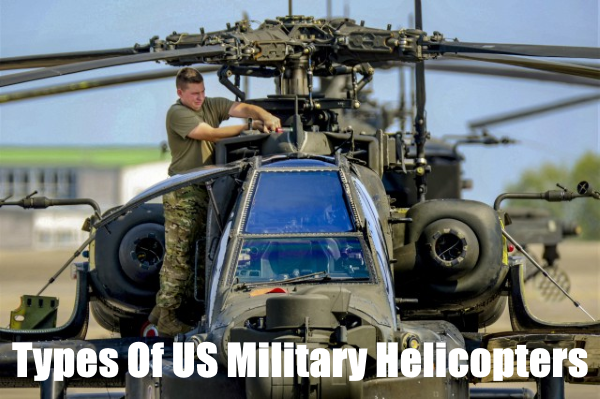U.S. military helicopters are among the most versatile weapons systems in the world.
They have an incredible history in the U.S. Armed Forces, as even casual observers can recognize a Huey or Chinook.
U.S. military helicopters serve a variety of purposes both during times of war and peace.
For this reason, the various types of military helicopters used by the U.S. military range from transport and utility to helicopters designed to attack.
Learn more about the most common helicopters currently used by the U.S. military.
Related Article – Army Helicopter Pilot Requirements
Table of Contents
Types of U.S. Military Helicopters
U.S. military helicopters have presented an enormous boost to the country since their inception in the 1940s.
Helicopters were first introduced to the military (along with many other aircraft) during World War II.
Later, U.S. military helicopters played a gigantic role in numerous foreign conflicts, including the invasion of Vietnam.
U.S. military helicopters are among the most revered for their incredible adaptability.
The rotors on helicopters enable military personnel to land and take off just about anywhere.
Moreover, military helicopters exceed many other types of military aircraft in that they can hover or fly in all 4 directions.
In general, the U.S. Armed Forces relies on 7 different types of military helicopters:
- Military Attack Helicopters
- Military Transport Helicopters
- Observational Helicopters
- Military Utility Helicopters
- Maritime Military Helicopters
- Multi-Purpose Helicopters
- Military Search and Rescue Helicopters
The various types of U.S. military helicopters are utilized for different purposes.
Below, we’ll examine 16 of the most prominent types of U.S. military helicopters.
#1. AH-1W Super Cobra
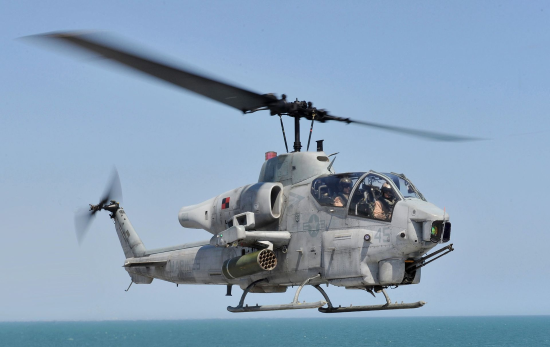
- Maximum Airspeed: 315 km/h
- Cruise Airspeed: 281 km/h
- Branch: U.S. Marine Corps
- Capacity: 2 crew (pilot and co-pilot/gunner)
- First Flight: 1985
- Manufacturer: Bell Textron
- Rotor: 4-bladed main rotor and 2-bladed tail-rotor
- Type: Military Attack Helicopter
The Super Cobra is among a fleet of military helicopters typically referred to as “attack helicopters.”
Like the name implies, the primary purpose of these U.S. military helicopters is to assault the enemy.
Thus, military attack helicopters like the AH-1W Super Cobra strike at high speeds with a well-supplied arsenal.
The Super Cobra is supplied with machine guns, missiles, and auto-cannons to attack the opposition.
Even more noteworthy, the AH-1W Super Cobra is modeled after the Huey design (more details, below).
For this reason, it’s the first attack helicopter used by the U.S. military to feature sidearm anti-radiation missiles as well as sidewinder air-to-air missile combat.
Moreover, the Super Cobra can support hellfire missiles making it a dangerous foe in the era of drones.
The AH-1W Super Cobra was first introduced in 1986 and deployed heavily during Operation Iraqi Freedom.
The Cobra is slowly being replaced by the AH-1Z Viper (more information, below).
Related Article – 12 Military Drones Employed By The US Military
#2. CH-47 Chinook
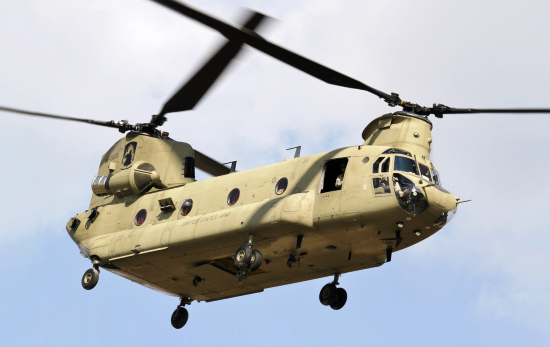
- Maximum Airspeed: 315 km/h
- Cruise Airspeed: 296 km/h
- Branch: U.S. Army
- Crew: 2-4 (pilot, copilot, flight engineer or loadmaster)
- Capacity: 44 troops / 20,600 lbs.
- First Flight: 1962
- Manufacturer: Boeing Vertol
- Rotor: Tandem
- Type: Transport Helicopter
The Chinook ranks among the most recognizable of the U.S. military helicopters and for good reason.
For starters, the massive helicopter is easy to identify from the ground.
Secondly, the enormous twin-engine (developed by Boeing) roars with its deadly tandem rotors.
The tremendous size of the aircraft makes the CH-47 Chinook ideal as a transport helicopter.
The U.S. relies heavily on military transport helicopters to move cargo over large distances, including oceans.
U.S. military helicopters that are designed for transport are capable of handling light vehicles, large groups of troops, and cargo in high altitudes – and over incredible distances.
The Chinook made its combat debut during Vietnam and was instrumental in delivering supplies to troops deep in the jungle.
What makes military transport helicopters vital (over other types of transport aircraft) is the ability to land or take off without a landing strip.
The CH-47 Chinook features an impressive legacy.
The transport giant has gone through several upgrades and is not expected to retire from duty until 2060.
It’s a legendary benchmark considering the Chinook will therefore become the first aircraft in the U.S. Army to reach 100 years.
Currently, the Chinook is undergoing some new designs yet remains crucial to U.S. Army supply routes.
The Block 2 Chinook (a second iteration of the CH-47 F-model and CH-47 G-model) currently serves the U.S. Army.
Related Article – Army CH-47 Helicopter Repairer (MOS 15U): Career Details
#3. CH-53E Super Stallion
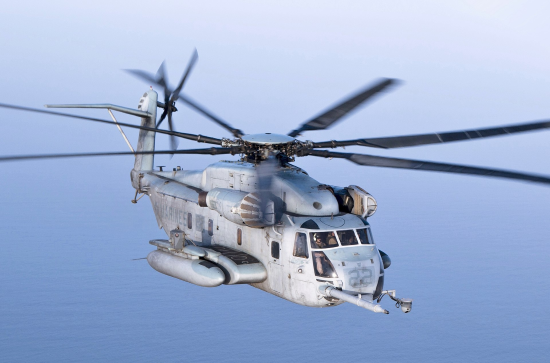
- Maximum Airspeed: 310 km/h
- Cruise Airspeed: 278 km/h
- Branch: U.S. Marine Corps
- Crew: 4 (pilots, co-pilot, crew chief, mechanic/gunner)
- Capacity: 31-55 troops / 36,000 lbs.
- First Flight: 1974
- Manufacturer: Sikorsky
- Rotors: 4
- Type: Military Transport Helicopter
The CH-53E Super Stallion is another powerhouse that serves the U.S. Armed Forces as a transport helicopter.
The Super Stallion is far more common during peacetime operations compared to the Chinook (which is ideal for serving combat operations).
Thus, it’s common to discover the CH-53E Super Stallion on television landing as foreign and military dignitaries meet to forge international relations.
The transport capacity of the Super Stallion is nothing short of amazing.
The 7-bladed main rotor gives it an astounding maximum takeoff weight of 73,500 lbs.
There is anticipation that the U.S. Marine Corps will continue to depend on the Super Stallion throughout the 2020s.
Lastly, it’s worth mentioning that Japan also trusts the CH-53E Super Stallion to serve them in the Japan Maritime Self-Defense Force.
Related Article – Navy Pilot Requirements
#4. MH-6 Little Bird
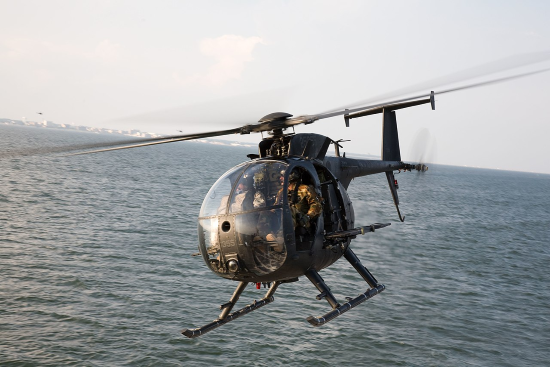
- Maximum Airspeed: 282 km/h
- Cruise Airspeed: 250 km/h
- Branch: U.S. Army
- Crew: 2
- Capacity: 6 Passengers
- First Flight: 1963
- Manufacturer: Hughes Helicopters / McDonnell Douglas
- Rotor: Single, 5-blade
- Type: Assault / Transport Helicopter
The MH-6 Little Bird is what the Armed Forces defines as a light attack helicopter.
The MH-6 provides a unique service to the U.S. military, primarily used to insert special operations forces.
The systems generally feature sensor and communication equipment that supports intelligence-gathering and reconnaissance missions.
Thus, the purpose of the MH-6 is to remain discreet while presenting high-tech and intelligence-gathering capabilities.
As a result, you’ll generally find helicopters like the MH-6 Little Bird equipped with advanced sensor suites, infrared cameras, communications equipment, and laser systems.
“The Killer Egg,” or what some affectionately call the Little Bird, also features fuel tanks that are resistant to small arms.
The Little Bird first became iconic in the film “Black Hawk Down” and carries a special reputation within the U.S. Army.
In fact, the MH-6M Little Bird is almost exclusively used by the elite 160th Special Operations Aviation Regiment.
The purpose of these aviation experts is to deposit troops, or “night stalkers” into very narrow spaces, often in the dark.
#5. OH-58 Kiowa Warrior
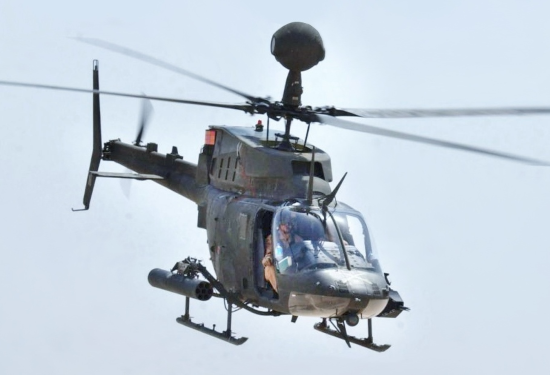
- Maximum Airspeed: 240 km/h
- Cruise Airspeed: 204 km/h
- Branch: U.S. Army
- Crew: 2 Pilots
- First Flight: 1983
- Manufacturer: Bell
- Rotor: Single, 4-blade
- Type: Observation Helicopter
The OH-58 Kiowa Warrior is another integral design of U.S. military helicopters.
The Kiowa is considered a stealth reconnaissance helicopter that is utilized by several different forces worldwide.
The OH-58 Kiowa Warrior is a single-engine, 4-blade helicopter that also features advanced weapons and navigation systems.
Consequently, the Kiowa is capable of launching assaults both day and night.
Moreover, the Kiowa Warrior can handle just about anything, including adverse weather and standoffs.
The U.S. Army currently utilizes the OH-58 Kiowa Warrior for various operations.
It’s popular among the branch for the ability to deploy minutes after arrival.
The OH-58 Kiowa Warrior was introduced in 1983 and was crucial during active combat missions during the Gulf War, the Invasion of Panama, and the War in Afghanistan.
Related Article – High School To Flight School
#6. UH-60 Black Hawk
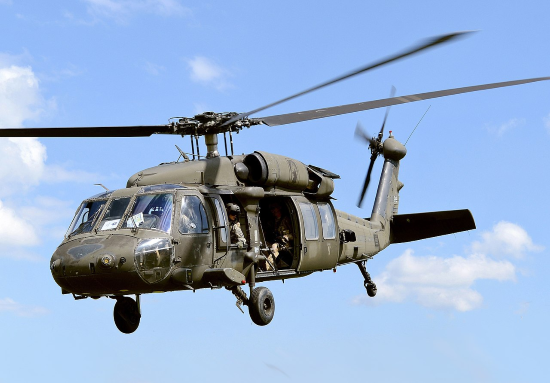
- Airspeed: 183 mph (294 km/h)
- Branch: U.S. Army
- Crew: 4 (2 pilots and 2 crew chiefs/gunners)
- Capacity: 11 troops / 3,190 lbs.
- First Flight: 1974
- Manufacturer: Sikorsky
- Rotor: 4-blade
- Type: Military Utility Helicopter
The UH-60 Black Hawk is defined by the military as a utility helicopter.
In other words, utility helicopters serve the military in various functions because they are extraordinarily versatile.
Thus, a utility helicopter is capable of surviving an assault or providing reconnaissance.
It’s why the Black Hawk ranks among the most well-known military helicopters.
The UH-60 Black Hawk is a twin-engine, 4-blade helicopter that currently serves the U.S. Army.
You can generally spot it from the ground due to the dragging tail with the landing gear system.
The tactical military helicopter is designed to operate in all weather conditions, including arctic environments.
Of course, the U.S. military helicopter first became idolized by the general public after the release of the film “Black Hawk Down” in 2001.
Today, numerous variants of the UH-60 Black Hawk exist in the U.S. Armed Forces.
Related Article – Army UH-60 Helicopter Repairer (MOS 15T): Career Details
#7. AH-1Z Viper
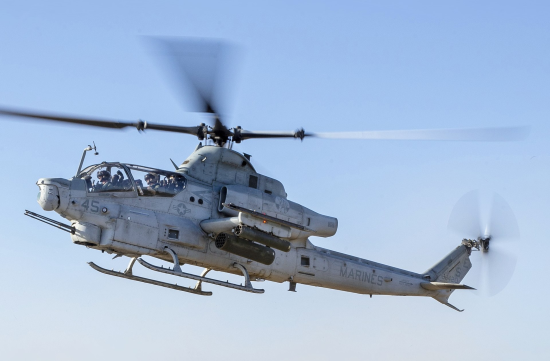
- Maximum Airspeed: 337 km/h
- Cruise Airspeed: 300 km/h
- Branch: U.S. Marine Corps
- Crew: 2 (pilot and co-pilot/gunner)
- First Flight: 2000
- Manufacturer: Bell
- Rotor: Single, 4-blade
- Type: Military Attack Helicopter
The AH-1Z Viper is set to replace the legendary Super Cobra as the primary attack helicopter for the U.S. military.
The impressive AH-1Z Viper is equipped with advanced radar that identifies enemy targets.
Additionally, the advanced military helicopter can guide projectiles worthy of destroying vehicles or tanks.
The U.S. Military relies on the lethal helicopter to provide air support for ground missions and other aircraft.
The Viper is young among the list of U.S. military helicopters as it wasn’t formally introduced until 2010.
#8. UH-1Y Venom
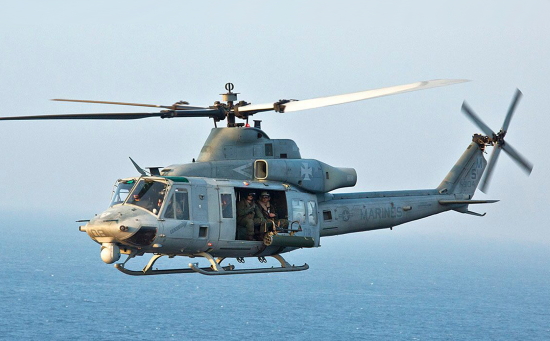
- Maximum Airspeed: 304 km/h
- Cruise Airspeed: 293 km/h
- Branch: U.S. Marine Corps
- Crew: 2 (pilot and co-pilot)
- Capacity: 10 troops / 6,660 lbs.
- First Flight: 2001
- Manufacturer: Bell
- Rotor: Single, 4-blade
- Type: Military Utility Helicopter
The UH-1Y Venom carries a reputation for being able to survive enormous obstacles.
The utility helicopter was destined to replace the iconic Huey after being introduced in 2008.
As a result, the UH-1Y Venom has been granted the nicknames “Super Huey” and “Yankee.”
The Super Huey presents a 50% increase in range and increased speed compared to the original Huey military helicopter.
Lastly, the Venom is also equipped to endure an attack, giving it a lot of versatility.
Related Article – USMC 61 Field (Helicopter Maintenance/Mechanic)
#9. UH-1 Iroquois (“The Huey”)
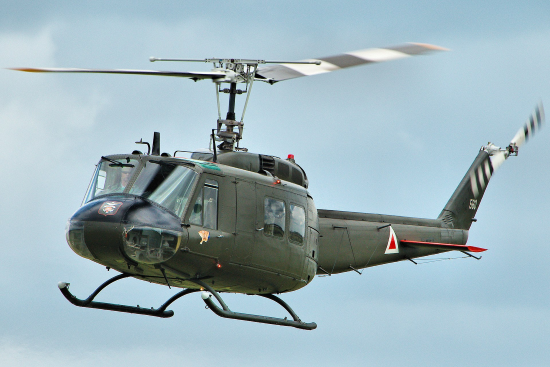
- Maximum Airspeed: 204 km/h
- Cruise Airspeed: 179 km/h
- Branch: U.S. Army
- Crew: 1-4
- Capacity: 11-14 troops /3,880 lbs.
- First Flight: 1956
- Manufacturer: Bell
- Rotor: Single, 2-blade
- Type: Utility Helicopter
The Iroquois, usually better known by its nickname “The Huey,” serves as a utility helicopter for the Armed Forces.
It attained legendary status by saving the lives of many soldiers that were critically injured in Vietnam.
The ability of the single-engine, light-lift helicopter to land in combat zones was essential in rescue operations.
Thus, the U.S. military had finally found a solution for providing medical evacuations (even during combat).
The UH-1 Iroquois Huey is capable of flying in day and night conditions.
The Huey has become highly valued by armed forces throughout the world that admire U.S. military helicopter design.
The Huey was the first turbine-engine aircraft produced for the US military and continues to remain in a limited circulation.
#10. MH-60R Seahawk
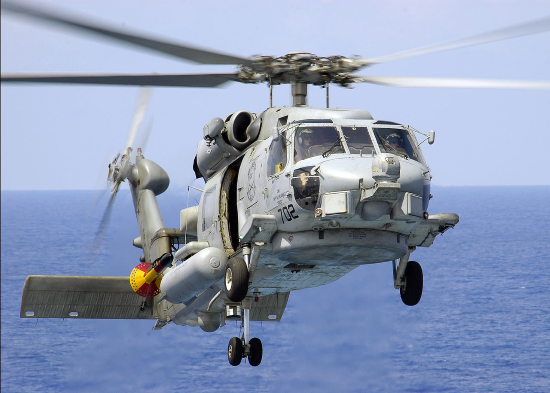
- Maximum Airspeed: 270 km/h
- Cruise Airspeed: 168 km/h
- Branch: U.S. Navy
- Crew: 3-4
- Capacity: 5 / 6,000 lbs.
- First Flight: 1979
- Manufacturer: Sikorsky
- Rotor: Single, 4-blade (with tail fin)
- Type: Maritime Helicopter
The MH-60R Seahawk is what the U.S. Armed Forces consider a maritime helicopter.
Maritime helicopters, as the name implies, primarily serve units that are stationed out in large bodies of water.
The U.S. Navy first developed maritime helicopters as a resource for search and rescue and surveillance.
However, maritime helicopters are also capable of providing air support and anti-submarine warfare.
The most popular maritime helicopter is the MH-60R Seahawk.
The Seahawk (also affectionately known as “Romeo”) serves the U.S. Navy in multiple capacities.
It’s a multi-mission helicopter that can provide air support against submarines as well as any surface weapon system.
The U.S. Navy still heavily relies on the MH-60R Seahawk to deliver the support and protection it needs.
#11. MH-65 Dolphin
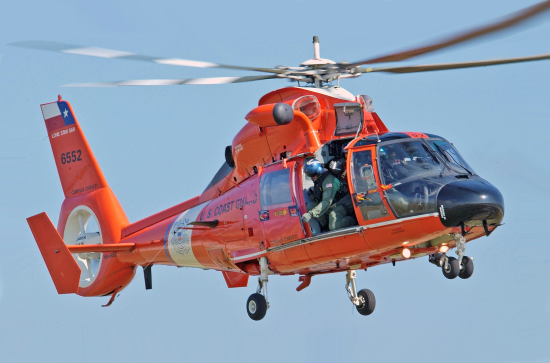
- Maximum Airspeed: 330 km/h
- Cruise Airspeed: 240 km/h
- Branch: U.S. Coast Guard
- Capacity: 2-4 (Pilots & Crew)
- First Flight: 1980
- Manufacturer: American Eurocopter
- Rotor: Single, 4-blade (with tail fin)
- Type: Military Search & Rescue Helicopters
The MH-65 Dolphin is crucial to the U.S. Coast Guard during search and rescue operations.
Search and rescue helicopters are traditionally very swift and agile.
Moreover, search and rescue helicopters usually handle all-weather environments and navigate challenging terrain.
The U.S. Coast Guard trusts the MH-65 Dolphin to provide search and rescue support over both the Pacific and Atlantic.
You’ll easily spot the two-engine, short-range recovery helicopter from the vibrant orange design.
The orange and white serve a purpose, however, as it allows the Coast Guard to conduct operations day and night.
The Dolphin military helicopter recently underwent several important upgrades including more advanced radar and avionics.
It continues to remain a stalwart among U.S. military helicopters as the primary search and rescue helicopter for the USCG.
#12. AH-64 Apache
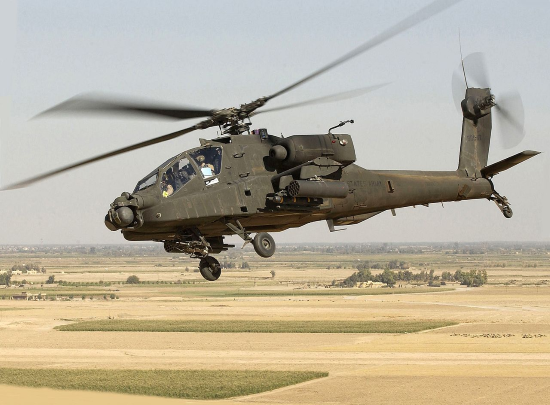
- Maximum Airspeed: 293 km/h
- Cruise Airspeed: 265 km/h
- Branch: U.S. Army
- Capacity: 2 (pilot and co-pilot/gunner)
- First Flight: 1975
- Manufacturer: Boeing
- Rotor: 2 (4-blade main and rear rotor)
- Type: Military Attack / Utility Helicopter
The Apache is a really versatile, underrated U.S. military helicopter.
It’s capable of supporting a wide range of operations and therefore several branches rely on its services.
The AH-64 Apache is fantastic at navigating difficult terrain and confined spaces.
It serves a lot of search and rescue missions as well as medivac and recovery operations.
The best way to identify the AH-64 Apache is the dual rotors and thunderous roar (thanks to the twin engine).
There are several advanced features onboard the Apache including sensor suites, avionics, and navigation.
The other distinguishing features of the U.S. military helicopter include shields between cockpits and night-vision systems.
Lastly, the Integrated Helmet and Display Sighting System (IHADSS) allows the pilot or gunner to aim the automatic M230 Chain Gun depending on where they look.
If that is not enough, the enemy will surely avoid the AGM-114 Hellfire missiles and Hydra 70 rockets.
Related Article – Army AH-64 Attack Helicopter Repairer (MOS 15R): Career Details
#13. UH-72A Lakota
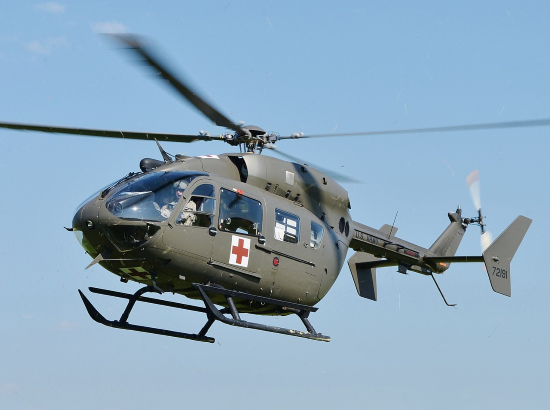
- Maximum Airspeed: 246 km/h
- Cruise Airspeed: 145 km/h
- Branch: U.S. Army, U.S. Navy
- Crew: 1-2
- Capacity: 9 troops / 3,953 lbs.
- First Flight: 2006
- Manufacturer: American Eurocopter
- Rotor: Single, 4-blade
- Type: Military Utility Helicopter
The UH-72A Lakota is scheduled to relieve the UH-1H/V Iroquois and OH-58 Kiowa Warrior from duty.
While it will be hard to say goodbye to these legends, the Lakota is impressive in many regards.
First, the multi-purpose helicopter is already utilized in U.S. Army training procedures.
The UH-72A Lakota offers a twin-engine and single, 4-blade main rotor.
Meanwhile, a single 2-blade tail rotor provides additional support for the light-duty helicopter.
For now, the UH-72A Lakota is primarily used by the U.S. Army National Guard, allowing their fleet of Black Hawks to deploy overseas.
It’s very important to medivac missions at the U.S. Army National Training Center (Forth Irwin, CA).
#14. MH-60 Jayhawk
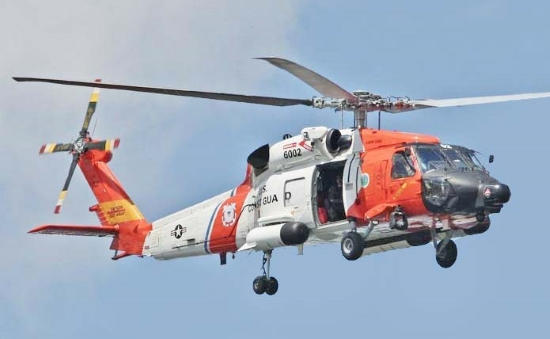
- Maximum Airspeed: 333 km/h
- Cruise Airspeed: 260 km/h
- Branch: U.S. Coast Guard
- Crew: 4 (pilot, co-pilot, two flight crew)
- First Flight: 1989
- Manufacturer: Sikorsky
- Rotor: Single, 4-blade
- Type: Military Multi-Purpose Helicopter
The MH-60 Jayhawk is a personal favorite among many that serve the U.S. Coast Guard.
The multi-purpose helicopter features two engines and drew inspiration from the design of the U.S. Navy Seahawk.
The U.S. Coast Guard primarily utilizes the Jayhawk for search and rescue missions.
Thus, the sight of an approaching Jayhawk can quickly become your best friend if you find yourself stranded at sea.
The MH-60 Jayhawk is capable of flying in all weather conditions and over difficult terrain.
Often, law enforcement and maritime drug operations rely on the support of the Jayhawk helicopter.
The MH-60 Jayhawk was also crucial to Operation Desert Storm and Operation Enduring Freedom.
Related Article – Coast Guard Rescue Swimmer: Pay, School, Training, And More
#15. V-22 Osprey
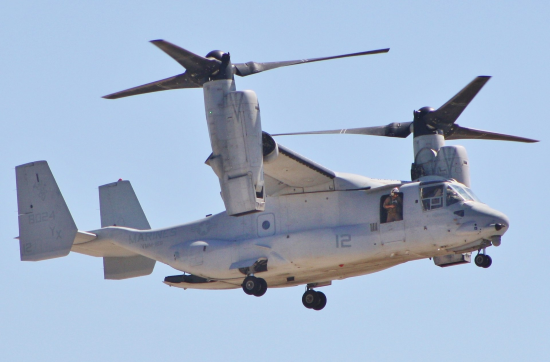
- Maximum Airspeed: 509 km/h
- Cruise Airspeed: 500 km/h
- Branch: U.S. Marine Corps, U.S. Navy, U.S. Air Force
- Crew: 4 (pilot, co-pilot, and 1-2 flight engineers/crew chiefs/gunners)
- Capacity: 24-32 troops / 20,000 lbs.
- First Flight: 1989
- Manufacturer: Bell Boeing
- Rotor: Tiltrotor
- Type: Military Multi-Purpose Helicopter / Helicopter
The V-22 Osprey is another honorable mention among the list of U.S. military helicopters..
This multi-purpose aircraft is generally needed during special operations in combat zones.
Why?
The V-22 Osprey is very unique because it takes off and lands like an helicopter.
However, the Osprey quickly transforms into a turbo-prop airplane once in the air, while a tilt-rotor motors the flight.
For this reason, the V-22 Osprey is easily one of the most unique helicopters in the U.S. military.
Currently, the U.S. Marine Corps (USMC) depends on a variety of Osprey designs to conduct operations.
The versatile military helicopter can handle everything from transportation to medivac.
#16. SH-3 Sea King
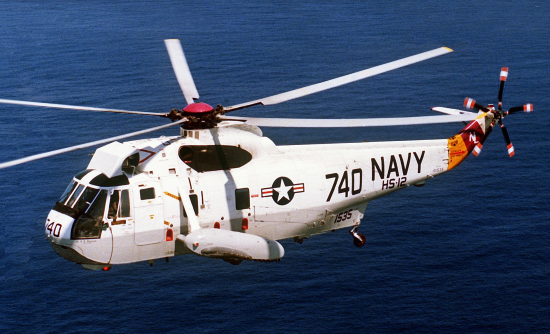
- Maximum Airspeed: 267 km/h
- Cruise Airspeed: 219 km/h
- Branch: U.S. Navy
- Crew: 4 (2 flight crew and 2 sonar operators)
- Capacity: 26 troops
- First Flight: 1959
- Manufacturer: Sikorsky
- Rotor: Single, 4-blade (with tail fin)
- Type: Anti-Submarine / Utility Helicopter
The SH-3 Sea King carries the distinction of providing transport for the President of the United States.
The twin-engine helicopter was manufactured by Sikorsky – which produced many of the other U.S. military helicopters.
Sikorsky is well known for their production standards and dependability.
Thus, it’s little surprise that the Leader of the Free World turned to the Sea King for transportation.
The SH-3 Sea King features a boat-like frame and pontoons that allow the aircraft to land on water.
For this reason, it’s often considered the first “amphibious” helicopter in the world.
Before the Sea King got into the hands of the U.S. President – it was previously in the service of the U.S. Navy for a half-century and currently, one version remains in service with the U.S. Marine Corps.
- Ikon Pass Military Discount: Learn How To Save Big - January 31, 2025
- RTIC Military Discount: Find Out How To Save Big on Gear - January 30, 2025
- Traeger Military Discount: Learn How To Save Big on Smokers - January 28, 2025

